|
 |
| Adult female, 6,500 ft., Mono County |
| |
|
|
 |
 |
 |
| Adult male, 9,300 ft. White Mountains, Inyo County |
Adult male, 9,300 ft. White Mountains, Inyo County |
 |
 |
 |
| Adult, 6.500 ft., Mono County |
Adult, 4,100 ft. Modoc County |
Adult female, 6,500 ft., Mono County |
 |
 |
 |
| |
Adult male, 6,800 ft., Inyo County |
|
 |
 |
 |
| Juvenile, 7,700 ft. Inyo County |
 |
 |
 |
 |
| Adult female with breeding coloring, Inyo County |
 |
 |
 |
Adult female from 9,994 ft. elevation in Death Valley National Park, Inyo County
© Peter Treuherz |
Close-up of a Southern Sagebrush Lizard that shows the orange coloring
behind the front legs and the black mark in front of the front legs that is usually found on Sagebrush Lizards. |
Sagebrush Lizards have overlapping scales with sharp spines on the back. |
| |
|
|
| Northern Sagebrush Lizards from Outside California |
 |
 |
 |
| Adult, Grant County, Washington |
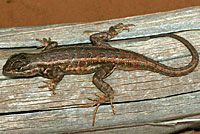 |
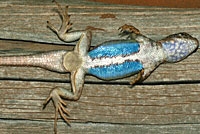 |
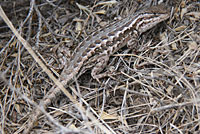 |
| Adult Male, San Juan County, Utah |
Adult, White Pine County, Nevada |
| |
|
|
| Habitat |
 |
 |
 |
Habitat, 9,300 ft. White Mountains,
Inyo County |
Habitat, Inyo County |
Habitat, Mono Lake, Mono County |
 |
 |
 |
| Habitat, 4,700 ft., Lassen County |
Habitat, 4,100 ft., Modoc County |
Habitat, 7,700 ft., Inyo County |
More pictures of this animal and its natural habitat can be seen on our Northwest and Southwest Herps pages.
|
| Short Videos |
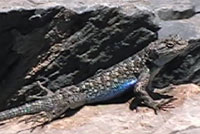 |
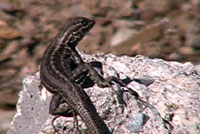 |
|
| Sagebrush lizards from the White Mountains in Inyo County. |
Several lizards from Mono and Inyo Counties, including a dual push-up display. |
|
|
|
|
| Description |
| |
| Size |
1 7/8 - 3 1/2 inches long from snout to vent (4.7 - 8.9 cm). (Stebbins 2003)
|
| Appearance |
A small lizard with small keeled and pointed scales overlapping on the upper surfaces of the body and limbs.
These scales are not as large as they are on other lizards of the genus Sceloporus.
The gular fold is incomplete.
The scales on the back of the thigh are mostly granular, not keeled (as they are on the Western Fence Lizard.) |
| Color and Pattern |
Color is gray or brown with dark blotches or irregular bands on the body and tail and distinct light and dark stripes along the sides and upper sides at the edge of the back.
There is usually a bar of black on the shoulder and rusty coloring on the armpits and sometimes on the sides of the body and the neck.
Unlike the Western Fence Lizard - Sceloporus occidentalis, there is normally no yellow coloring on the rear of the limbs. |
| Male / Female Differences |
Males have a patch of blue color on each side of the belly and on the throat.
The blue belly patches do not meet across the belly and do not meet the blue on the throat.
Male postanal scales are enlarged, and the base of the tail is broader than on the female.
The throat is light blue mottled with white spots.
Sometimes the blue patch is reduced or even absent.
Some males may develop bright orange breeding coloring.
Females have little or no blue on the belly.
When breeding, females may develop orange coloring on the sides and neck and yellow underneath. |
| Young |
Young lizards have little or no blue on the belly.
|
| Differences Between Subspecies of Sagebrush Lizards in California |
|
| Differences Between the Sagebrush Lizard and the Similar Western Fence Lizard in California |
| |
| Life History and Behavior |
Activity |
Diurnal.
Active spring through fall.
Hibernates during winter.
A good climber and jumper, able to quickly jump from rock to rock.
Lives mostly on the ground near bushes, logs, rocks, or brush piles.
Often observed basking on rocks and logs.
|
| Territoriality |
| Males defend their territory and try to attract females with head-bobbing and a push-up display that exposes the throat and ventral colors. |
| Defense |
Escapes danger by running into rocks, rodent burrows, or brush or climbs up trees or rock outcrops.
The tail can break off easily, but it will grow back. The detached tail wriggles on the ground which can distract a predator from the body of the lizard allowing it time to escape.
More information about tail loss and regeneration. |
| Diet and Feeding |
| Eats a variety of small invertebrates, including ants, termites, grasshoppers, flies, spiders, and beetles. |
| Reproduction |
Females lay 1 or 2 clutches of 2 - 10 eggs from June to August.
|
| Habitat |
Lives in sagebrush and other types of shrublands, mainly in the mountains (at higher elevations than the Western Fence Lizard). Prefers open areas with scattered low bushes and lots of sun.
|
| Geographical Range |
In California, this subspecies occurs in the Great Basin desert east of the Sierra Nevada and in the northeast corner of the state. It ranges north into eastern Washington and east into southern Idaho, Montana, Wyoming, Nebraska, Utah, Colorado, Arizona and New Mexico.
The species Sceloporus graciosus occurs in California, Eastern oregon, central Washington, southern Idaho parts of Montana and North Dakota, in much of Wyoming, Utah, western Colorado, northwest New Mexico, northern Arizona, and in the Sierra San Pedro Martir of northern Baja California.
|
 |
| Elevational Range |
The species Sceloporus graciosus is found at elevations of
500 ft. to about 10,500 ft. (150 - 3,200 m) (Stebbins 2003).
|
| Notes on Taxonomy |
Three subspecies of Sceloporus graciosus are recognized in California:
Sceloporus graciosus gracilis - Western Sagebrush Lizard,
Sceloporus graciosus graciosus - Northern Sagebrush Lizard, and
Sceloporus graciosus vandenburgianus - Southern Sagebrush Lizard.
Sceloporus graciosus vandenburgianus has been described as a unique species, Sceloporus vandenburgianus.
"Chan et al. (2013, Zootaxa 3664: 312–320) found that the currently recognized subspecies of S. graciosus are incongruent with mitochondrial haplotype clades, which often exhibit relatively deep divergences between geographically proximate samples, and that S. graciosus is paraphyletic relative to S. arenicolus. Although these findings suggest that S. graciosus is in need of taxonomic revision, those authors did not propose any taxonomic changes."
(SSAR Herpetological Circular No. 43, 2017)
Alternate and Previous Names (Synonyms)
Sceloporus graciosus graciosus - Northern Sagebrush Lizard (Stebbins 1966, 1985)
Sceloporus graciosus graciosus - Sagebrush Lizard (Smith 1946)
Sceloporus graciosus graciosus - Mountain Lizard (Sceloporus consobrinus, Sceloporus consobrinus gratiosus; New Mexican Alligator Lizard; Sage-brush Swift,part; Fence Lizard, part; Marcy's Alligator Lizard) (Grinnell and Camp 1917)
|
| Conservation Issues (Conservation Status) |
| This subspecies is listed as sensitive by the Bureau of Land Management. |
|
|
Taxonomy |
| Family |
Phrynosomatidae |
Zebra-tailed, Earless, Fringe-toed, Spiny, Tree, Side-blotched, and Horned Lizards |
Fitzinger, 1843 |
| Genus |
Sceloporus |
Spiny Lizards |
Wiegmann, 1828 |
| Species |
graciosus |
Common Sagebrush Lizard |
Baird and Girard, 1852 |
Subspecies
|
graciosus |
Northern Sagebrush Lizard |
Baird and Girard, 1852 |
|
Original Description |
Sceloporus graciosus - Baird and Girard, 1852 - Proc. Acad. Nat. Sci. Philadelphia, Vol. 6, p. 69
from Original Description Citations for the Reptiles and Amphibians of North America © Ellin Beltz
|
|
Meaning of the Scientific Name |
Sceloporus - Greek -skelos leg and porus - pore or opening - refers to the femoral pores on hind legs
graciosus - Latin - graciosus graceful - "This small and graceful species..."
from Scientific and Common Names of the Reptiles and Amphibians of North America - Explained © Ellin Beltz
|
|
Related or Similar California Lizards |
Sceloporus graciosus gracilis - Western Sagebrush Lizard
Sceloporus graciosus vandenburgianus - Southern Sagebrush Lizard
Uta stansburiana - Common Side-blotched Lizard
Sceloporus occidentalis - Western Fence Lizard
|
|
More Information and References |
California Department of Fish and Wildlife
Stebbins, Robert C., and McGinnis, Samuel M. Field Guide to Amphibians and Reptiles of California: Revised Edition (California Natural History Guides) University of California Press, 2012.
Stebbins, Robert C. California Amphibians and Reptiles. The University of California Press, 1972.
Flaxington, William C. Amphibians and Reptiles of California: Field Observations, Distribution, and Natural History. Fieldnotes Press, Anaheim, California, 2021.
Samuel M. McGinnis and Robert C. Stebbins. Peterson Field Guide to Western Reptiles & Amphibians. 4th Edition. Houghton Mifflin Harcourt Publishing Company, 2018.
Stebbins, Robert C. A Field Guide to Western Reptiles and Amphibians. 3rd Edition. Houghton Mifflin Company, 2003.
Behler, John L., and F. Wayne King. The Audubon Society Field Guide to North American Reptiles and Amphibians. Alfred A. Knopf, 1992.
Powell, Robert., Joseph T. Collins, and Errol D. Hooper Jr. A Key to Amphibians and Reptiles of the Continental United States and Canada. The University Press of Kansas, 1998.
Bartlett, R. D. & Patricia P. Bartlett. Guide and Reference to the Turtles and Lizards of Western North America (North of Mexico) and Hawaii. University Press of Florida, 2009.
Jones, Lawrence, Rob Lovich, editors. Lizards of the American Southwest: A Photographic Field Guide. Rio Nuevo Publishers, 2009.
Smith, Hobart M. Handbook of Lizards, Lizards of the United States and of Canada. Cornell University Press, 1946.
Brown et. al. Reptiles of Washington and Oregon. Seattle Audubon Society,1995.
Nussbaum, R. A., E. D. Brodie Jr., and R. M. Storm. Amphibians and Reptiles of the Pacific Northwest. Moscow,
Idaho: University Press of Idaho, 1983.
St. John, Alan D. Reptiles of the Northwest: Alaska to California; Rockies to the Coast. 2nd Edition - Revised & Updated. Lone Pine Publishing, 2021.
Joseph Grinnell and Charles Lewis Camp. A Distributional List of the Amphibians and Reptiles of California. University of California Publications in Zoology Vol. 17, No. 10, pp. 127-208. July 11, 1917.
|
|
|
The following conservation status listings for this animal are taken from the January 2024 State of California Special Animals List and the January 2024 Federally Listed Endangered and Threatened Animals of California list (unless indicated otherwise below.) Both lists are produced by multiple agencies every year, and sometimes more than once per year, so the conservation status listing information found below might not be from the most recent lists. To make sure you are seeing the most recent listings, go to this California Department of Fish and Wildlife web page where you can search for and download both lists:
https://www.wildlife.ca.gov/Data/CNDDB/Plants-and-Animals.
A detailed explanation of the meaning of the status listing symbols can be found at the beginning of the two lists. For quick reference, I have included them on my Special Status Information page.
If no status is listed here, the animal is not included on either list. This most likely indicates that there are no serious conservation concerns for the animal. To find out more about an animal's status you can also go to the NatureServe and IUCN websites to check their rankings.
|
| Organization |
Status Listing |
Notes |
| NatureServe Global Ranking |
G5T5 |
Secure |
| NatureServe State Ranking |
S3 |
Vulnerable
|
| U.S. Endangered Species Act (ESA) |
None |
|
| California Endangered Species Act (CESA) |
None |
|
| California Department of Fish and Wildlife |
None |
|
| Bureau of Land Management |
S |
Sensitive |
| USDA Forest Service |
None |
|
| IUCN |
None |
|
|
|





































